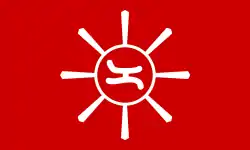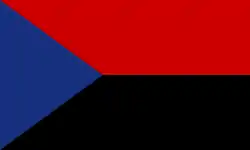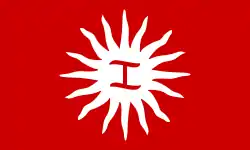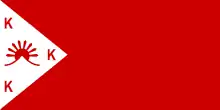Flags of the Philippine Revolution
During the Philippine Revolution, various flags were used by the Katipunan secret society and its various factions, and later, after the Katipunan had been dissolved, the Philippine Army and its civil government.
Other flags were the personal battle standards of different military zone commanders operating around Manila.
The flags shown in this article are the official flags recognized during the Philippine Centennial celebration in 1998. These flags are often erroneously included in the "Evolution of the Philippine Flag"; these are properly called "Flags of the Revolution". While many of the depicted symbols and layouts on some of the flags have inspired the national flag, there is no direct relationship.
Katipunan flags

With the establishment of the Katipunan, Andrés Bonifacio requested his wife, Gregoria de Jesús, to create a flag for the society. De Jesús devised a simple red flag bearing the society's acronym, KKK, in white and arranged horizontally at the center. This became the society's first flag.
Some Katipunan members used other variations. One variation has the three Ks arranged in the form of a triangle. Some others used a red flag with only one K.

When the revolution heated up, the Magdiwang faction of the Katipunan, which operated in Cavite under Mariano Álvarez, adopted a flag consisting of a red banner with a white sun with the baybayin (the ancient Tagalog script) letter ka (for K) at the center.

The Magdalo faction of the Katipunan, which also operated in Cavite under Emilio Aguinaldo, used a flag similar to the Magdiwang faction's, featuring a white sun with a baybayin letter ka. The sun initially had an indefinite number of rays and was later standardized to eight rays, to represent the eight provinces that Spanish colonial authorities placed under martial law (Manila, Cavite, Laguna, Batangas, Bulacan, Pampanga, Bataan, and Nueva Ecija). An eight-rayed sun was later used in the national flag of the Philippines.
Personal flags

As the Katipunan's Supremo, Andrés Bonifacio had a personal flag which depicts a white sun with an indefinite number of rays on a field of red. Below the sun are three white Ks arranged horizontally. This flag was first unveiled on August 23, 1896 during the Cry of Pugadlawin where the assembled Katipunan members tore their cedulas (community tax certificates) in defiance of Spanish authority. The flag was used later during the Battle of San Juan del Monte on August 30, 1896, the first major battle of the Philippine Revolution.

General Mariano Llanera who fought in the provinces of Bulacan, Tarlac, Pampanga, and Nueva Ecija used a black flag with a white K on the left and a white skull and crossed bones on the right, resembling the Jolly Roger. Bonifacio referred to the flag as Bungo ni Llanera or Llanera's Skull.

General Pío del Pilar used a red banner which has a white equilateral triangle on the mast with a K at each corner. At the center of the triangle was a mountain with the sun rising behind it. The flag was called Bandila ng Matagumpay (Flag Of the Triumphants) and was first used on July 11, 1895. The flag was also one of the first to depict an eight-rayed sun.

General Gregorio del Pilar used a tricolor banner with a blue triangle at the mast and a red stripe at the top of the flag and a black stripe at the bottom. Del Pilar patterned his flag after that of Cuba's, which then was also revolting against Spain.
First official Filipino flag

At the Naic Assembly of March 17, 1897, the Katipunan military leaders decided to adopt a flag with a new design. This new flag was red and depicted a white sun with eight rays and a face. This flag became the first official flag of the Filipinos. The flag was used for less than a year because the Filipino leaders signed a truce with Spanish authorities on December 14 to 15, 1897.
Modern revival

A flag reminiscent of the Katipunan flags of the past was used by a breakaway faction of army officers calling themselves Bagong Katipuneros,[3] but labeled the Magdalo Group by the press. These officers mutinied against the government of Gloria Macapagal-Arroyo at the behest of Senator Gregorio Honasan and once again led by Senator Antonio Trillanes IV (see Oakwood mutiny and Manila Peninsula mutiny).
References
- "The History of the Philippine Flag" (PDF). Merit Badge Center, Philippines. Retrieved 12 June 2016.
- "PHILIPPINE FLAG PICTURES EVOLUTION of the FILIPINO FLAG". PHILIPPINE-HISTORY.ORG. Retrieved 12 June 2016.
- Laurel, Herman T (22 February 2006). "Small setback..." The Daily Tribune. Archived from the original on 2007-09-28. Retrieved 2007-08-10.
- “The Evolution of the Philippine Flag.” MSC's Philippine Centennial Celebration Website.
- “History of the Philippine Flag.” National Commission for Culture and the Arts.
- “Philippines – Historical Flags.” Flags of the World.



